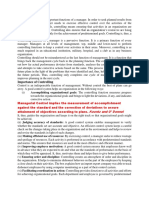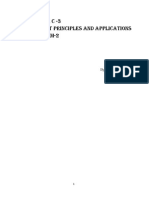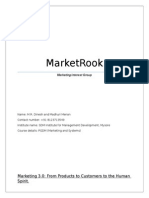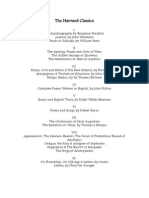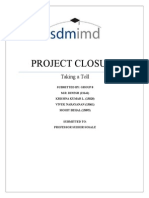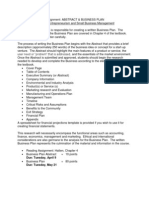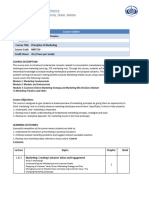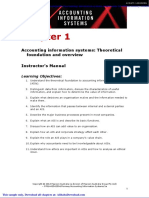Q1
Q1
Uploaded by
Dinesh RaghavendraCopyright:
Available Formats
Q1
Q1
Uploaded by
Dinesh RaghavendraCopyright
Available Formats
Share this document
Did you find this document useful?
Is this content inappropriate?
Copyright:
Available Formats
Q1
Q1
Uploaded by
Dinesh RaghavendraCopyright:
Available Formats
Q1. Planning is looking forward. Controlling is looking backward. Explain Control is an indispensable function of management.
Without control the best of plAns. can go awry. A good control system helps an organization in the following ways: (i) Accomplishing organizational goals: the controlling function measures progress towards the organizational goals and brings to light the deviations, if any, and indicates corrective action. (ii) Judging accuracy of standards: a good control system enables management to verify whether the standards set are accurate or not. An efficient control system keeps a careful check on the changes taking place in the organization and in the environment and helps to review and revise the standards in light of such changes. (iii) Making efficient use of resources: By exercising control, a manager seeks to reduce wastage and spoilage of resources. This ensures that resources are used in the most effective and efficient manner. (iv) Improving employee motivation: a good control system ensures that employees know well in advance what they are expected to do and what are the standards of performance on the basis of which they will be appreciated. (v) Ensuring order and discipline: Controlling creates an atmosphere of order and discipline in the organization. It helps to minimize dishonest behaviors on the part of the employees by keeping a close check on their activities. (vi) Facilitating coordination in action: Controlling provides direction to all activities and efforts for achieving organizational goals. Following are the steps of controlling process: (i) Setting Performance Standards: the first step of controlling is to set performance standards. Standards are those criteria s on the basis of which the actual performance is measured. Thus, standards serve as benchmarks towards which an organization strives to work. Standards can be set in both quantitative as well as qualitative terms. (ii) Measurement of Actual Performance: the second step in the controlling process is the measurement of actual performance. The measurement of actual
performance is done on the basis of pre-determined standards. The measurement of actual performance tells the manager whether the work has been done according to the plan or not. (iii) Comparison of Actual Performance with Standards: At this step, actual performance is compared with the standards and deviations are found out. (iv) Analyzing Deviations: Deviations are examined the light of pre-determined Deviation Tolerance Limits. If the deviations are within limits they can be avoided. But if they cross the limits, they should be reported to the higher level managers without any delay. There are two important principles regarding this: (a) Principle of Critical Point Control: According to this principle, those activities should be determined in the very outset which have an important role to play in ensuring the actual work progress in accordance with the plans. These are known as Key Result Areas KRAs. It means that the managers should not be involved in small insignificant activities but should pay more attention to those activities where unfavourable results can cause heavy loss to the enterprise. (b) Management by Exception; Management by exception, is an important principle of management control based on the belief that an attempt to control everything results in controlling nothing. Thus, only significant deviations which go beyond the permissible limit should be brought to the notice of management. (v) Taking Corrective Action: The last but the most important step in the controlling process is taking corrective action. By now the deviations and their causes become known. Now is the turn of removing the hurdles in the actual work progress. The purpose of corrective action is to bring the actual work progress to the level of expected progress.
The characteristics of Control is: Universal Continuous process Action-based and Looking Back.
5. What are the importance of controlling? The importance of controlling are: Control helps to review, revise and update the policy of the organization The sound control system inspires employees to work hard and give better performance. Control helps to increase the coordination of the subordinates in the organization Proper control ensures organization effectives and efficiency.
8. Give some critical point standards of control.
Cost Standards Revenue standards Goal standards Program standards
9. What are the types of control? Feedback control Concurrent control Feed forward control
Feedback control is the process of adjusting future action on the basic of information about the past performance.
Concurrent control This control measures for taking corrective action while any programme meets any obstacle in the activities.
Feed forward control
Feed forward control is preventive in nature. This control involves evaluation of inputs and taking corrective action before a particular operation is completed.
The traditional techniques of control are: Personal observation Break Even Analysis Statistical Report and Budgetary control.
The modern techniques of control: Management Audit Return on Investment PERT & CPM and MIS.
Planning is the most basic of all management functions since it involves deciding of future course of action. The other functions of management, viz., organising, staffing, directing and controlling, must reflect proper planning. A manager organises, directs and controls to ensure the accomplishment of predetermined goals according to plans. Thus, planning logically precedes the execution of all other managerial functions. Although, all the functions intermesh in practice, planning is unique in the sense that it establishes the objectives for the group effort and lays down steps to accomplish them before the manager proceeds to perform other functions.
Definition of Planning Planning is the process of deciding in advance what is to be done, who is to do it, how it is to be done and when it is to be done. It is the determination of a course of action to achieve the desired results. It bridges the gap from where we are to where we want to go. It makes it possible for things to occur which would not otherwise happen. Planning is a mental process requiring the use of intellectual faculties, imagination, foresight and sound judgement. In the words of Koontz, ODonnell and Weihrich, Planning is an intgllectually demanding process; it requires the conscious determination of courses of action and the basing of decisions on purpose, knowledge and considered estimates. Planning involves anticipation of future course of events and deciding the best course of action. It is basically a process of thinking before doing. To plan is to produce a scheme for future action; to bring about specified results, at specified cost, in a specified period of time. It is a deliberate attempt to influence, exploit, bring about and control the nature, direction, extent, speed and effects of change. It may even attempt deliberately to create change, remembering always that change (like decision) in any one sector will in the same way affect other sectors. Planning is a deliberate and conscious research used to formulate the design and orderly sequence of actions through which it is expected to reach the objectives. Thus, we can say that planning is a systematic attempt to decide a particular course of action for the future. It leads to determination of objectives of the group activity and the steps necessary to achieve them. From
this, we can conclude that planning is the selecting and relating of facts and the making and using of assumptions regarding the future in the visualisation and formulation of proposed activities believed necessary to achieve desired results.
Planning involves selecting missions and objectives and the actions to achieve them; it requires decision-making, that is, choosing from among alternative future courses of action. The four basic steps in the planning process are given below:
Step 1: Planning begins with the decisions about what the organization or sub-unit wants or needs. Without a clear definition of goals, the organization spread their resources too broadly. Identifying priorities and being specific about their aims enable organizations to focus.
Step 2: How far is the organization or the sub-unit from its goals? What resources are available for reaching the goals? Only after the current state of affairs is analyzed can plans be drawn up to chart further progress. Open lines of communication within the organization and between its subunits provide the information- especially financial and statistical data- necessary for this second stage.
Step 3: What factors in the internal and external environments can help the organization reach its goals? What factors might create problems? It is comparatively easy to see what is taking place now, but the future is never clear. Although difficult to do, anticipating future situations, problems, and opportunities is an essential part of planning.
Step 4: The final step in the planning process involves developing various alternative courses of action for reaching the desired goal or goals, evaluating these alternatives, and choosing from among them the most suitable alternative for reaching the goal. This is the step in which decisions about future actions are made and where the guidelines for effective decision making are most relevant.
Nature of Planning The nature of planning can be highlighted by studying the following characteristics: (i) Planning is an Intellectual Activity: Planning involves vision and foresightedness to decide the things to be done in future. It bridges the gap between where we are and where we want to go. It is not a simple process. It involves use of mental skills for the achievement of group objectives. (ii) Planning Involves Selection among Alternatives: Planning is a choice activity. The planning process involves finding of alternatives and selection of the best alternative to achieve specified objectives. Thus, decision making is an integral part of planning. Every manager finds himself surrounded by many alternatives. He has to pick up the best one. (iii) Planning is Forward-Looking: Planning means looking ahead. It is carried out to achieve
some objectives in future. It may involve forecasting of future events such as customers, demand, competition, government policies, etc. In other words, the manager attempts to handle future events effectively through the process of planning. Thus, planning is futuristic in nature. (iv) Planning is Related to Objectives: Every plan specifies the objectives to be attained in the future and steps necessary to reach them. As Billy E. Gotez said, Plans forecast which actions will tend towards the ultimate objective...Managerial planning seeks to achieve a consistent, coordinated structure of operation focused of desired ends. (v) Planning is the Most Basic of all Management Functions: Since managerial operations in organising, staffing, leading, and controlling are designed to support the accomplishment of enterprise objectives, planning logically precedes the execution of all other managerial functions. (vi) Planning is a Pervasive Function of Management: Planning is a function of all managers, although, the character and breadth of planning will vary with their authority and with the nature of policies and plans outlined by their superiors.
Types of Planning We can classify planning on the basis of the following dimensions: 1. Organisational Level: Corporate, divisional and functional planning. 2. Focus: Strategic, operational and tactical planning. 3. Time Period: Long-range, medium-range and short-range planning. Focus of Planning The focus of managerial planning may be on developing (i) strategic (ii) operational and (iii) tactical plans as discussed below: (i) Strategic Planning: Strategic planning is the process of deciding the objectives of the organisation and determining the manner in which the resources of the enterprise are to be deployed to realise the objectives in the uncertain environment. A strategy represents the general direction of the organisational efforts. It is the way in which the management choose to utilise the organisation resources to reach its objectives. It involves multilateral relationships among the organisation, its resources and the environment. Strategic plans are made by the top management of the firm after taking into account the firms strengths and weaknesses in the light of internal and external environment.
(ii) Operational Planning: Operational planning is concerned with the efficient use of the resources already allocated and with the development of a control mechanism to ensure efficient operation so that organisational objectives are achieved. It lays down programmes, budgets, projects policies, procedures, rules, etc., to implement the strategic plan. In other words, an operational plan (also called tactical planning) involves laying down how the firms resources of the organisation will be used to help the firm achieve its objectives. Operational plans provide the details of how the strategic plans will be accomplished. In other words, the details that activate the strategic plan are domain of operational planning. An operational plan is often more specific than a strategic plan. (iii) Tactical Planning: Tactical plans are made for short-term moves and maneuvers things necessary for supporting the strategic plans and achieving firms objectives. They are required to meet the challenges of sudden changes in the environmental forces. For instance, tactical plans may be made to handle a sudden fall in the demand of firms products of unexpected move by a competitor. Tactical planning may also become necessary to secure big orders by changing the price policy, terms of credit and discount, etc. The nature of a tactical plan is dictated by the threats posed by the environment. Range or Time Span of Planning Business plans may be classified on the basis of time span covered into three categories, namely (i) long range (ii) medium range, and (iii) short range. (i) Long Range Planning: Long Range planning is the process of establishing long-term goals, working out strategies, policies and programmes to achieve these goals. In other words, long range planning sets long-term goals for the enterprise and formulates strategic plans for attaining these goals. It involves an attempt to anticipate, analyse and make decisions about basic problems which have significant effects well beyond the present operating horizon of the enterprise. Long range planning is done by the top management. Long range planning generally covers a period ranging from 5 years to 20 years or even more. The period will vary from organisation to organisation. It may be five years for a departmental store and at least twenty-five years for a company intending to take up the production of timber. The purpose of long range planning may include technological leadership, increase in market
share, globalisation of production and marketing, public image, etc. Long range planning may involve capital budgeting, product planning, project planning, acquisition of competing units. It may involve a complete change in outlook of the business. It deals with the broad technological, financial and competitive aspects of the business. Because of this, long range planning is associated with a great deal of uncertainty. Its success will be determined by the ability of the organisation to predict and deal with the environment. (ii) Intermediate or Medium Range Planning: Intermediate plans are made to support the medium term plans. They may relate to development of new products and markets, product publicity, increasing return on investment from the existing products and markets, etc. They are more detailed than the long range plans. Coordination between different departments is given greater emphasis. Medium-term planning usually covers a period of more than one year but less than five years. The length of period may vary from one business to another depending upon the nature of business, risks and uncertainties, government control, changes in technology, nature of market, etc. (iii) Short Range Planning: Short range planning relates to period of upto one year, generally. Such plans are made to achieve short-term goals. Short range planning is concerned more with the current or near-future operations of the enterprise. It may be considered as a step by step approach to medium and long range planning. Short range plans are instrumental in implementing long-term plans. They are quite specific in nature such as change of product design, training of workforce, reduction of inventory levels, preparation of production budget and so on. Short-range planning is generally action-oriented and is the responsibility of lower level managers. Essential Requirements of an Effective Plan An effective plan is one which helps in the better management of the enterprise. In order to be effective, a plan should possess the following characteristics: (1) The Plan should be Specific: The more specific it is, the less chance there is for it to be misinterpreted. Objectives should be clearly defined. The means for carrying out the plan should also be indicated in unambiguous terms.
(2) The Plan should be Specific: The more specific it is, the better it is. If facts are not available, reasonable assumptions must be made about the future. (3) The Plan should be Complete and Integrated: A plan is said to be complete when it is comprehensive enough to cover all actions expected from integrated one when various administrative plans are so welded into one another that the whole undertaking operates at the peak of its efficiency. (4) The Plan should be Flexible: No plan is infallible nor can it cover all possible contingencies. Conditions under which a plan will be most effective change as do the variables and factors on which the plan is formulated. Therefore, it is essential to introduce some flexibility in every plan. (5) The Plan should be Capable of being Controlled: Effective planning of business activities depends upon the ability to foresee with utmost accuracy the nature and requirements of future events relating to industry in general and the business undertaking in particular. Therefore, the plan must distinguish between controllable future environment for better administrative control. Planning Premises Planning involves taking of decisions by the management on the basis of assumptions of what is likely to happen in the future. These assumptions may be referred to as planning premises since they constitute the basis of planning. Such assumptions are nothing but forecasts about the likely shape of events in future. Every manager assumes that certain entities will behave in a particular way. The assumptions are not merely based on experience or intuition but also on systematic prediction with the help of quantitative techniques. Planning premises constitute the framework within which planning is done. They provide the bedrock upon which the future course of action is based. In order to have effective planning, the plans must be based on sound premises. Therefore, the premises should be based on systematic forecasting. Though, derivation of premises in the form of forecasts is a rigorous form of research activity which involves huge cost, it is essential to enhance the effectiveness of planning. These forecasts are based upon both past events as well as expected events. It is wrong to say that only future estimates are taken as planning premises. Past events are a useful guide for deriving reliable planning premises.
The relationship between planning and controlling can be divided into the following two parts. (i) Interdependence between Planning and Controlling. (ii) Difference between Planning and Controlling.
(i) Interdependence between Planning and Controlling. Planning is meaningless without controlling and controlling is blind without Planning. Both the aspects of the interdependence of planning and control have been discussed below: (a) Planning is meaningless without Controlling: if the process of controlling is taken away from management no person working in the enterprise will take it seriously to work according to the plans and consequently, the plans will fail. (b) Controlling is blind without Planning: Under the system of controlling actual work performance is compared with the standards. Hence, if the standards are not determined there is no justification left for control and the standards are determined under planning. Planning is an analytic and decision making process that ends when a specific plan is developed. Plans are implemented through detailed actions aimed at realizing specific objectives. It is at this action-taking stage that planning moves into another management function, controlling.
Controlling can be simply defined as the process of ensuring that actions conform to plans. This definition shows the close relationship between planning and control. Controlling cannot take
place unless a plan exists, and a plan has little chance of success unless some efforts are made to monitor its progress.
Control compares information about what is really happening during a plans implementation with the budgets, programs, standards, and so on called for and predicted during the planning stages (planned data).
The following table shows the important interrelationships between planning and control. As you can see, the control process does not begin after the entire planning process ends, as most managers believe. After objectives are set in the first step of the planning process, appropriate standards should be developed for them. Standards are units of measurement established to serve as a reference base and are useful in determining time lines, sequences of activities, scheduling, and allocation of resources.
The Planning-Control Relationship Planning Establish the goals Define the present situation Determine aids and barriers Develop a set of actions Measure and compare Evaluate results Feedback and coach Take corrective action Controlling Establish standards
(ii) Difference between Planning and Controlling Yes, planning and controlling are incomplete and ineffective without each other but it doesnt mean that both are not independent. Reasons are: (a) Planning is looking Ahead whereas Controlling is Looking Back: Plans are always formulated for future and determined the future course of action for the achievement of objectives laid down. On the contrary, controlling is looking back because under it a manager tries to find out, after the work is completed, whether it has been done according to the standards or not. (b) Planning is the first function and Controlling is the last function of Managerial Process: the managerial process moves in a definite sequence- like planning, organizing, staffing, directing and controlling happens to be the last step.
You might also like
- The Controlling Function in ManagementDocument50 pagesThe Controlling Function in Managementahetasam67% (6)
- McKinsey 7S Framework of Nestle LTD ScribdDocument2 pagesMcKinsey 7S Framework of Nestle LTD Scribdsreeya57% (7)
- Developing A Fundraising StrategyDocument3 pagesDeveloping A Fundraising Strategydnlkaba100% (1)
- Marketing Analysis of NestleDocument40 pagesMarketing Analysis of NestleFaizanSheikh100% (3)
- 9 ElectronicArtsDocument10 pages9 ElectronicArtslishugo100% (4)
- Hsslive Xii Bs Chapter 8 Controlling BinoyDocument11 pagesHsslive Xii Bs Chapter 8 Controlling Binoyeminent career academyNo ratings yet
- Management Control Systems: Sandeep SahasrabudheDocument65 pagesManagement Control Systems: Sandeep SahasrabudhePranav RamnaniNo ratings yet
- MISDocument8 pagesMISKavita SinghNo ratings yet
- Controlling Control in OrganizationsDocument5 pagesControlling Control in OrganizationsJulius MwambiNo ratings yet
- M2 Notes Part 1Document20 pagesM2 Notes Part 1Akhil SankarNo ratings yet
- Unit 3- Final Copy (1)-1-42Document42 pagesUnit 3- Final Copy (1)-1-42SyedNo ratings yet
- Controlling Is One of The Important Functions of A ManagerDocument4 pagesControlling Is One of The Important Functions of A ManagerMelkamu DessalegnNo ratings yet
- Fundamentals of Management (FOM) Unit-5Document12 pagesFundamentals of Management (FOM) Unit-5ganeswar8No ratings yet
- Controlling TechniquesDocument40 pagesControlling TechniquesArun PrasadNo ratings yet
- CHAPTER 3-5 MGT (1) .OdtDocument38 pagesCHAPTER 3-5 MGT (1) .OdtBehailu TejeNo ratings yet
- Concept and Process of Control: Management Principles and Its ApplicationDocument29 pagesConcept and Process of Control: Management Principles and Its ApplicationAbhishek SinghNo ratings yet
- Chapter Seven 2022Document19 pagesChapter Seven 2022abdiimohammedadamNo ratings yet
- ControllingDocument4 pagesControllingSeema ModiNo ratings yet
- Business Organization & Management Dr. Nuzhath Khatoon: Unit 4 Planning & OrganizingDocument38 pagesBusiness Organization & Management Dr. Nuzhath Khatoon: Unit 4 Planning & OrganizingDr. Nuzhath KhatoonNo ratings yet
- Unit 3Document52 pagesUnit 3harshjayant24No ratings yet
- Management of Control: Semester-1 Ishita Niwas Aditya Kumar Verma Aryan Gupta Harsh SinghDocument32 pagesManagement of Control: Semester-1 Ishita Niwas Aditya Kumar Verma Aryan Gupta Harsh Singhharsh singhNo ratings yet
- Nature and Process of ControllingDocument25 pagesNature and Process of ControllingCfa Deepti Bindal100% (1)
- Controlling Meaning & Definition in Management.Document4 pagesControlling Meaning & Definition in Management.amrin jannatNo ratings yet
- Nature of PlanningDocument5 pagesNature of PlanningpanchtaniNo ratings yet
- CONTROLLINGDocument62 pagesCONTROLLINGDaisuke InoueNo ratings yet
- CHAPTER 7 ControllingDocument4 pagesCHAPTER 7 ControllingDhanielle MamucodNo ratings yet
- Group I MwangangiDocument10 pagesGroup I Mwangangijoansada23No ratings yet
- Strategic Audit: The Evaluation and Control of Organization Strategy 4 Steps Process of ControlDocument8 pagesStrategic Audit: The Evaluation and Control of Organization Strategy 4 Steps Process of ControlKathleen Joy LurechaNo ratings yet
- Q1) Shorts Notes:-A) Management ControlDocument15 pagesQ1) Shorts Notes:-A) Management ControlSagar YadavNo ratings yet
- PLANNINGDocument5 pagesPLANNINGNimalanNo ratings yet
- Pom 2Document58 pagesPom 2anbuselvansakthivel2003No ratings yet
- Unit 2Document12 pagesUnit 2Vikas RathodNo ratings yet
- CONTROLLINGDocument5 pagesCONTROLLINGLilac_o9No ratings yet
- ControllingDocument5 pagesControllingHimkar GuptaNo ratings yet
- Planning & ControllingDocument7 pagesPlanning & ControllingloveruchinNo ratings yet
- Sem-2 CC3 Notes Unit-VDocument17 pagesSem-2 CC3 Notes Unit-VSneha TolagiNo ratings yet
- Sem-2 CC3 Notes Unit-VDocument17 pagesSem-2 CC3 Notes Unit-VSneha TolagiNo ratings yet
- Chapter SevenDocument4 pagesChapter SevenAd FikNo ratings yet
- Mpa FinalDocument9 pagesMpa FinalShashwat GoyalNo ratings yet
- Chapter 8 Chapter 8. Controlling-1599071834870Document3 pagesChapter 8 Chapter 8. Controlling-1599071834870Harsh SahukarNo ratings yet
- FoM Unit 5 PDFDocument10 pagesFoM Unit 5 PDFFuzail ZaidiNo ratings yet
- enc=encoded=8SgBNu5QrYrAusFswNLLwC7Q5Rq2AMjo2R7Oqw (1)Document120 pagesenc=encoded=8SgBNu5QrYrAusFswNLLwC7Q5Rq2AMjo2R7Oqw (1)kabilanselvakumar313No ratings yet
- ControllingDocument14 pagesControllingsukh singhNo ratings yet
- Chapter - 8 ControllingDocument6 pagesChapter - 8 ControllingyusraNo ratings yet
- Unit 3 MPDocument64 pagesUnit 3 MPs_87045489No ratings yet
- PoM RevisionDocument38 pagesPoM RevisionGeraldwerreNo ratings yet
- Fucntions of ManagementDocument70 pagesFucntions of Managementshivam modanwalNo ratings yet
- 2 Functions of ManagementDocument4 pages2 Functions of ManagementNaga sai ChallaNo ratings yet
- Unit TwoDocument16 pagesUnit TwotizitaNo ratings yet
- Controlling UNIT - VDocument75 pagesControlling UNIT - VJoel GiftsonNo ratings yet
- POM UNIT - V (1)Document78 pagesPOM UNIT - V (1)janusara2004No ratings yet
- Controlling FunctionDocument3 pagesControlling FunctionutkarshvermalifeNo ratings yet
- Strategic Evaluation and Control: Formulation: ImplementationDocument5 pagesStrategic Evaluation and Control: Formulation: ImplementationMary Monique Llacuna LaganNo ratings yet
- Controlling, Management Principle and Organisational Behavior, MpobDocument35 pagesControlling, Management Principle and Organisational Behavior, MpobDaphneusmsNo ratings yet
- Unit 2 Process of ManagementDocument113 pagesUnit 2 Process of ManagementJatinder KaurNo ratings yet
- Chapter 1 (Short)Document21 pagesChapter 1 (Short)Rakib IslamNo ratings yet
- Planning Is The Basis of ControlDocument3 pagesPlanning Is The Basis of Controlanilvrt78% (9)
- PLAN and OrgDocument20 pagesPLAN and OrgabdiNo ratings yet
- Unit 7Document11 pagesUnit 7Kundan SinhaNo ratings yet
- Principles of Management - AnsDocument11 pagesPrinciples of Management - AnsVishal NaikNo ratings yet
- oRGANicayion ManabgetmentDocument4 pagesoRGANicayion ManabgetmentIrish LudoviceNo ratings yet
- PIMR (FOM) Unit II 0IIIDocument64 pagesPIMR (FOM) Unit II 0IIIshivam gangradeNo ratings yet
- 1500 Relocation Expense BillDocument1 page1500 Relocation Expense BillDinesh RaghavendraNo ratings yet
- Mary PJT 120324 DMD 24-3-22Document9 pagesMary PJT 120324 DMD 24-3-22Dinesh RaghavendraNo ratings yet
- PPP Between BLR and SJDocument2 pagesPPP Between BLR and SJDinesh RaghavendraNo ratings yet
- Mandatory Document ListDocument1 pageMandatory Document ListDinesh RaghavendraNo ratings yet
- Symbiosis Institute of Management Studies (SIMS) : National Foundation For Corporate Governance (NFCG)Document3 pagesSymbiosis Institute of Management Studies (SIMS) : National Foundation For Corporate Governance (NFCG)Dinesh RaghavendraNo ratings yet
- Chapter 7 SolutionsDocument2 pagesChapter 7 SolutionsDinesh Raghavendra100% (1)
- Accounts ExecutiveDocument3 pagesAccounts ExecutiveDinesh RaghavendraNo ratings yet
- Opportunity For Europe: MARCH 2016Document8 pagesOpportunity For Europe: MARCH 2016Dinesh RaghavendraNo ratings yet
- Mig Marketing 3.0 SdmimdDocument6 pagesMig Marketing 3.0 SdmimdDinesh RaghavendraNo ratings yet
- The Harvard ClassicsDocument5 pagesThe Harvard ClassicsDinesh RaghavendraNo ratings yet
- Project Closure: Taking A TollDocument4 pagesProject Closure: Taking A TollDinesh RaghavendraNo ratings yet
- Books Read in 2014Document1 pageBooks Read in 2014Dinesh RaghavendraNo ratings yet
- Dinesh13141@sdmimd - Ac.in Madhuri13152@sdmimd - Ac.inDocument4 pagesDinesh13141@sdmimd - Ac.in Madhuri13152@sdmimd - Ac.inDinesh RaghavendraNo ratings yet
- Sip ReportDocument52 pagesSip ReportDinesh RaghavendraNo ratings yet
- Back PageDocument2 pagesBack PageDinesh RaghavendraNo ratings yet
- Financial AnbalysisbpsmDocument2 pagesFinancial AnbalysisbpsmDinesh RaghavendraNo ratings yet
- 487 Abstract+Business PlanDocument1 page487 Abstract+Business PlanDinesh RaghavendraNo ratings yet
- Marketing Services: Generic Package Details of SEO & SEMDocument10 pagesMarketing Services: Generic Package Details of SEO & SEMDinesh RaghavendraNo ratings yet
- Sample WhitepaperDocument6 pagesSample WhitepaperDinesh RaghavendraNo ratings yet
- C7 Term Paper InterimDocument10 pagesC7 Term Paper InterimDinesh RaghavendraNo ratings yet
- Countertrade - An Innovative Approach To Marketing: By: Dan West, Chairman American Countertrade AssociationDocument44 pagesCountertrade - An Innovative Approach To Marketing: By: Dan West, Chairman American Countertrade AssociationabhijeetsinghkNo ratings yet
- Business Development ProcessDocument9 pagesBusiness Development ProcessmeghaamalNo ratings yet
- HRDDocument7 pagesHRDjawadNo ratings yet
- BSC in Public SectorDocument13 pagesBSC in Public SectorpeksiNo ratings yet
- International Journal of Research in Management & Social Science Volume 2, Issue 3 (II) - July To September 2014 ISSN: 2322-0899Document185 pagesInternational Journal of Research in Management & Social Science Volume 2, Issue 3 (II) - July To September 2014 ISSN: 2322-0899empyrealNo ratings yet
- Mikesbikes-Advanced Players Manual: (For Version 6.67.5.2 and Later)Document70 pagesMikesbikes-Advanced Players Manual: (For Version 6.67.5.2 and Later)Vijay ShahNo ratings yet
- Creative Technic 9133277506: Marketing Topic ListDocument6 pagesCreative Technic 9133277506: Marketing Topic ListAhmedNo ratings yet
- Course Outline Principles of MarketingDocument4 pagesCourse Outline Principles of MarketingLaiba KanwalNo ratings yet
- Accounting Information Systems Australasian 1st Edition Romney Solutions ManualDocument37 pagesAccounting Information Systems Australasian 1st Edition Romney Solutions ManualAlea NadaNo ratings yet
- Unit 3 New Venture PromotionDocument33 pagesUnit 3 New Venture Promotioncooldudee08No ratings yet
- Philippine Christian UniversityDocument4 pagesPhilippine Christian UniversityMina SaflorNo ratings yet
- Services MarketingDocument46 pagesServices MarketingKiran MayiNo ratings yet
- Marketing ManagementDocument16 pagesMarketing Managementplume23No ratings yet
- International School of Management and EconomicsDocument6 pagesInternational School of Management and EconomicsChuc Do Thanh ThanhNo ratings yet
- Vision Paper RevisedDocument12 pagesVision Paper Revisedapi-364437018No ratings yet
- Module 5Document48 pagesModule 5Sasmi ShamsNo ratings yet
- Fans - Maintenance StrategyDocument14 pagesFans - Maintenance Strategyralexml100% (1)
- POM AssignmentDocument5 pagesPOM AssignmentSurìyáNo ratings yet
- International Logistics and Supply Management - Alan CarrollDocument190 pagesInternational Logistics and Supply Management - Alan Carrolllongpham67No ratings yet
- What Is Strategic ManagementDocument26 pagesWhat Is Strategic ManagementShivanshuBelongsToYouNo ratings yet
- Cooperatives and Rural MarketsDocument168 pagesCooperatives and Rural MarketsDhanraj WaghmareNo ratings yet
- Organization Design &structureDocument70 pagesOrganization Design &structurebijay100% (2)
- MRT Medical Devices PDFDocument64 pagesMRT Medical Devices PDFtecxv100% (1)
- Building Competitive Advantage Through Functional-Level Strategy Session 3Document34 pagesBuilding Competitive Advantage Through Functional-Level Strategy Session 3Yandex PrithuNo ratings yet
- Customer Engagement, Buyer-Seller Relationships, and Social MediaDocument38 pagesCustomer Engagement, Buyer-Seller Relationships, and Social Medialee_me_leeNo ratings yet
- The Solution Evaluation in Business AnalysisDocument24 pagesThe Solution Evaluation in Business AnalysisAnonymous PbCsXeZ100% (1)











